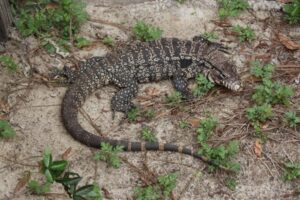
Deerfield-News.com-Deerfield Beach, Fl-From myfwc.com-
Argentine black and white tegu
Description
The Argentine black and white tegu (Salvator merianae) is a large South American lizard that is not native to Florida. Argentine black and white tegus have a mottled black and white coloration that often is arranged into a banding pattern across the back and tail. Hatchlings display similar markings, but possess a distinct bright green coloration on their head that fades after they reach about one month of age.
In both its native and introduced range, the Argentine black and white tegu occupies savannas and disturbed habitats such as forest clearings, roadsides and fence rows. In northwestern Argentina, tegus are found from sea level to altitudes of up to 4,100 feet. They are terrestrial lizards that rarely climb more than a few feet off the ground and are strong swimmers that can be observed in a variety of freshwater and marine environments. Tegus retreat into burrows during winter months while they undergo a hibernation-like period of inactivity known as brumation. They begin to emerge from their burrows in February.
Breeding in Florida occurs in March. Female tegus reach reproductive maturity after their second year of brumation or at approximately 12 inches in length from the tip of the nose to the base of the tail and lay an average of 35 eggs per year. Females construct nests of dried vegetation, often at the base of trees, in clumps of tall grass or in burrows. Eggs incubate for approximately 60 days and require stable temperatures for successful hatching. After hatching, juvenile tegus grow quickly. Tegus may live up to 20 years, reach sizes of nearly 4 feet in total length and weigh close to ten pounds.
Diet
Tegus have an omnivorous diet and consume fruits, eggs, insects, small animals including reptiles and rodents, and may consume pet food that has been left outdoors.
Native Range
 The Argentine black and white tegu is native to Brazil, Paraguay, eastern Uruguay and northern Argentina.
The Argentine black and white tegu is native to Brazil, Paraguay, eastern Uruguay and northern Argentina.
Florida Distribution
Reproducing populations of Argentine black and white tegus are established in Hillsborough and Miami-Dade Counties. An emerging population was recently discovered in Charlotte County after several confirmed reports were received through the Florida Fish and Wildlife Conservation Commission (FWC) Exotic Species Hotline. Researchers believe these populations occurred through escapes or intentional pet releases. Argentine black and white tegus have also been reported from other Florida counties, though these observations are most likely isolated occasions of escaped or released pets and not related to successful breeding populations. Some limited observations of red tegus (Salvator rufescens) and gold tegus (Tupinambis teguixin) have also been recorded in Florida.
TEGU SIGHTINGS
Visit IveGot1.org for a map of credible tegu sightings.
Potential Impacts
Potential impacts of tegus include competition with and preying upon Florida’s native wildlife, including some imperiled and protected species. Tegus prey upon the nests of other animals, and researchers have documented tegus eating American alligator eggs and disturbing American crocodile nests in Florida. Recent gut content analysis of tegus by the FWC revealed that they consume threatened juvenile gopher tortoises and agriculturally valuable foods, thus highlighting the impact this species may have on sensitive wildlife and agricultural lands. Though current population estimates are not available for this species, evidence suggests possible expansion of their populations. Adults have few predators and can give birth to large numbers of offspring per year, increasing the risk of populations spreading beyond their established counties and impacting surrounding areas.
Regulatory Status
The State of Florida lists tegus as Class III wildlife. A permit is not currently required to possess tegus as personal pets, but the state does require a License to Possess Class III Wildlife for Exhibition and/or Public Sale to possess these reptiles for commercial use and a Captive Wildlife Importation Permit to import them into the state.






























